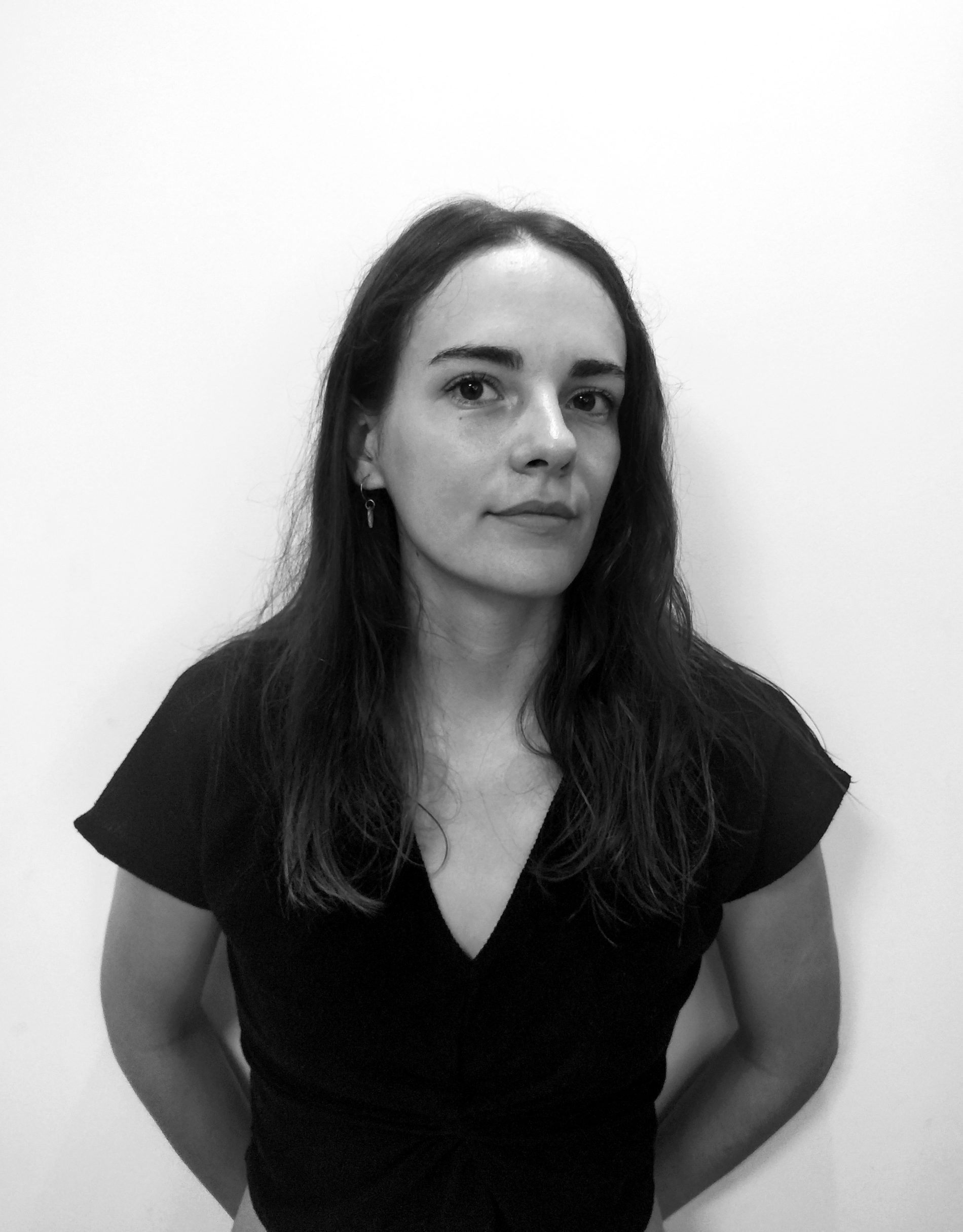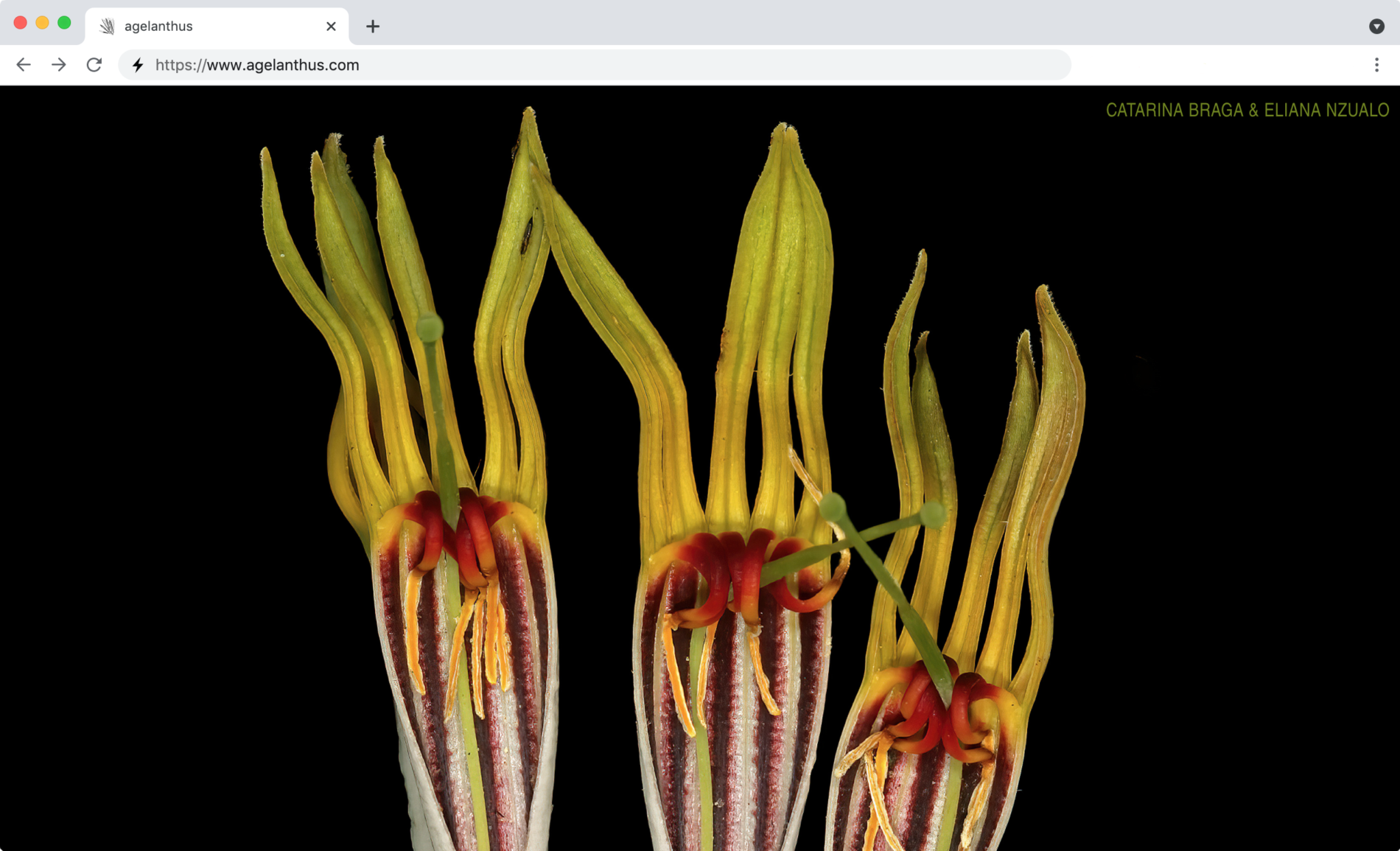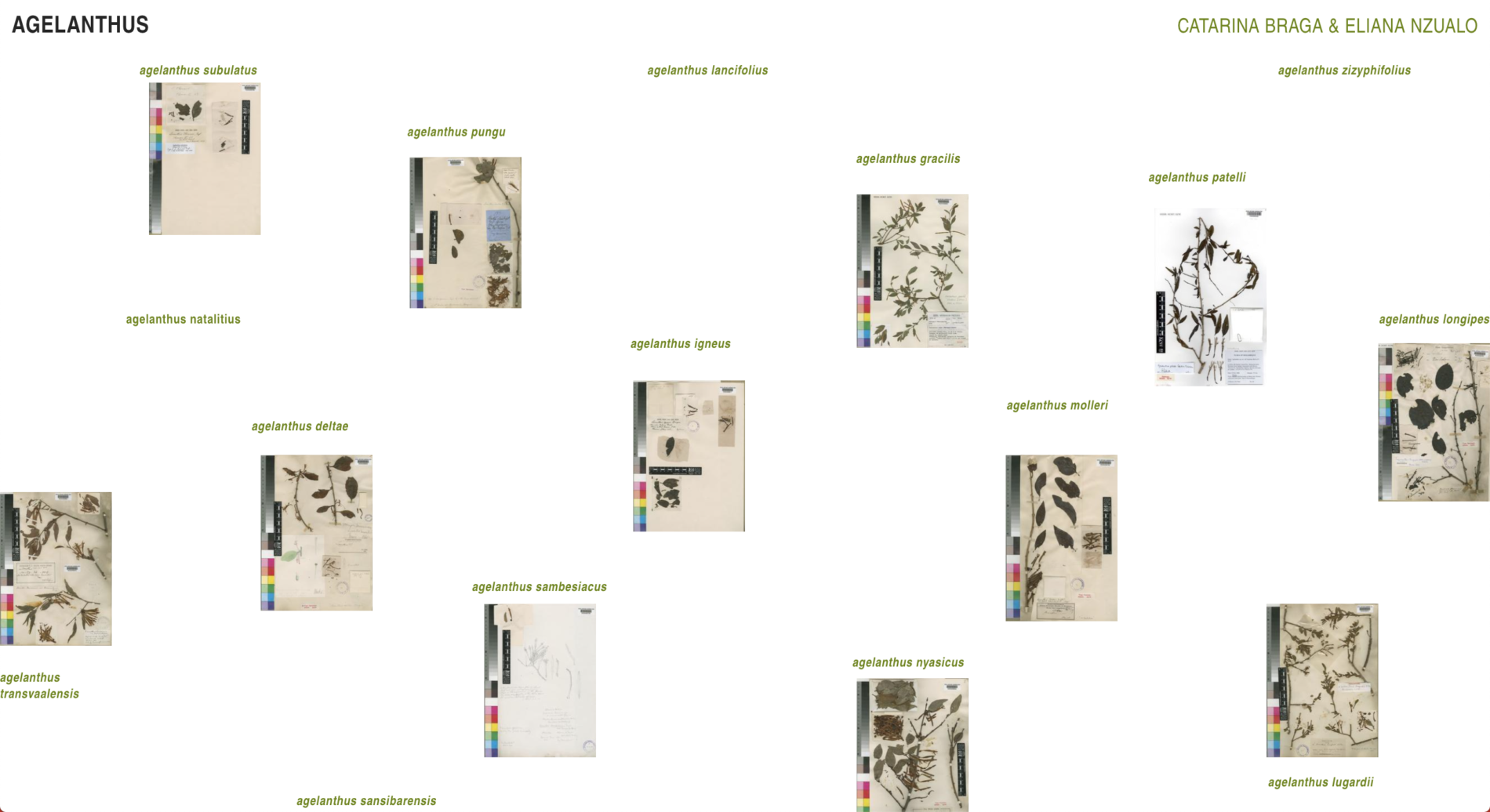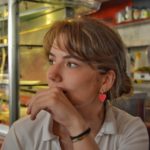MAGAZINE
[ENGLISH VERSION BELLOW]
Catarina Braga (Guimarães, 1994) vive e trabalha entre Guimarães e Porto. Actualmente frequenta o Mestrado em Artes Plásticas – Intermedia (2020-2022), na Faculdade de Belas Artes da Universidade do Porto, e é licenciada em Artes Plásticas – Multimedia pela mesma instituição (2016). Na sua prática artística, a artista investiga como a mediação tecnológica molda a nossa relação com a natureza, abordando processos de cultivo de plantas e processos de produção de imagem explorando o papel que as imagens desempenham nas interações que estabelecemos entre o mundo cultural e o mundo natural.
Catarina foi selecionada para a primeira edição do projeto Cross-Cultural Collaboration como artista Portuguesa, em conjunto com Eliana Nzualo, artista Moçambicana. Neste artigo exploramos um pouco como o seu interesse por arte começou e se desenvolveu, entrado em detalhe no processo da colaboração artistica – Agelanthus. As mesmas perguntas foram colocadas a ambas as artistas, resultando num interessante contraste de opiniões e visões acerca do mesmo produto artistico, da colaboração e do projeto CCC. (vê a entrevista da Eliana aqui: https://wendy.network/interview-eliana-nzualo-cross-cultural-collaboration-pt-and-eng-version/ )
Quando começou o teu interesse por arte? Qual foi a tua motivação para te tornares artista?
O mundo artístico sempre esteve muito presente na minha vida. A minha mãe é ceramista e o meu pai sempre trabalhou no Museu, por isso o espaço de atelier museu foram lugares que, desde que me lembro, habitei de forma recorrente. Não consigo dissociar o meu interesse pela arte da forma como cresci e o ambiente que me rodeava. Não posso dizer que houve alguma motivação especial para me tornar artista. Em retrospectiva, parece-me que o meu percurso se direccionou nesse sentido de uma forma bastante natural.
De onde vem a tua necessidade de criar arte? E como descreverias a tua arte?
A necessidade de criar arte vem do mesmo lugar da necessidade de comunicar. A arte é apenas outra linguagem que podemos utilizar para falarmos de coisas que as palavras não conseguem alcançar.
Não sei se me atrevo a descrever o meu trabalho artístico… Neste momento estou a investigar como a mediação tecnológica molda a nossa relação com a natureza, explorando a partir da instalação, do vídeo e das plantas; várias questões que se relacionam com processos de cultivo de plantas e processos de produção de imagem.
O que te atraiu nesta residência? Qual é a importância de colaborações internacionais na Arte, e de uma colaboração como o CCC?
Fiquei muito interessada nesta residência pelo facto de ser uma residência de colaboração com outra artista. Ultimamente tenho-me apercebido que o trabalho em conjunto com outras pessoas e artistas é mais significativo para mim. O processo de descoberta que existe em conjunto é bastante rico. Acho que a importância deste tipo de colaborações internacionais é precisamente esse: descoberta. O ritmo de trabalho é outro, e às vezes é desafiante poder articular com outra artista um processo tão íntimo como o processo artístico. Mas essa navegação, ou antes, a predisposição para navegar, permite-nos aprender novas capacidades. Gosto muito de trabalhar sozinha e de pensar sozinha, estou habituada ao meu processo de fazer as coisas e confesso que dá-me muito prazer descobrir as coisas sozinha. Ou pensava eu. À medida que fui trabalhando com a Eliana, ambas fomos descobrindo novas coisas e articulando vontades. No trabalho colaborativo surge um outro tipo de prazer no processo – o da surpresa. Acho importante este tipo de colaborações no meio artístico porque surgem sempre imensas coisas de que não estamos à espera. É um processo muito enriquecedor.
A partilha da língua materna facilitou a colaboração?
Acho que sim, porque nos permitiu partilhar referências (literárias e artísticas, mas também culturais, sociais e históricas) que não estão acessíveis ou presentes noutras línguas.
Como se desenvolveu este processo colaborativo? Foi sempre claro qual seria o produto final?
Desde o início que tivemos sempre em mente a criação de uma página online enquanto plataforma para apresentarmos o trabalho desenvolvido. Como tivemos apenas um mês de residência, e grande parte desse tempo foi passado a descobrir o que seria o trabalho em conjunto, não pudemos explorar muitas possibilidades. Achámos que faria sentido fazermos com que o próprio processo de trabalho coincidisse com o objecto artístico. No fundo o trabalho é uma exploração de vários sentidos que o género de plantas agelanthus nos estimula; a página online espelha essa investigação e exploração. As sessões de mentoria que tivemos ao longo da residência foram também muito importantes para direcionar e aprofundar o trabalho.
Porquê a agelanthus?
O ponto de partida da residência, para mim, foi começar a identificar as espécies nativas de Moçambique e perceber que plantas pudessem ter sido levadas de Portugal para o território moçambicano durante o colonialismo. Durante a investigação sobre as plantas nativas da ecozona afrotropical, onde Moçambique se situa, encontrei este género de plantas hemi-parasitas, a agelanthus, que me pareceu tanto a mim, como à Eliana, potenciar o trabalho que tínhamos pensado para a residência. Permitiu-nos abrir outros diálogos que surgiram a partir do seu comportamento vegetal: a questão do enraizamento, a apropriação, a representação de conhecimento e a construção de identidade. Ao mesmo tempo continua a fazer-nos pensar sobre a diáspora luso e afrodescendente mas também a diáspora vegetal, as relações colonialistas entre Portugal e Moçambique, entre outras, que estiveram presentes desde o início. Além disso, as flores da agelanthus são belíssimas, e por isso também nos permitem um tempo de contemplação e fascínio por estas entidades.
Existe alguma intenção de ver a agelanthus ao vivo, ou isso quebraria o feitiço?
Adoraria ver uma agelanthus ao vivo! Poder tocar nela!
Não sei se isso quebraria o feitiço. Talvez. Certamente que a partir desse momento a planta deixaria de ser para mim esta entidade fantasma. A sua existência tornou-se presente através da investigação que fomos fazendo. A partir do momento em que posso conviver com esta planta diretamente, não só a relação que tenho com ela se transformaria totalmente, mas também o trabalho passaria por essa transformação. O trabalho que surgiu tem precisamente a ver com um certo fetichismo da planta, o que significa para o estudo botânico, o que representa a nível social, político e cultural. Mas nós nunca poderemos saber o que ela é para si própria. Vê-la ao vivo poderá trazer-me mais próxima dela, da agelanthus enquanto agelanthus, sem qualquer tipo de mediação. Até agora o trabalho foi sobre a perspectiva antroponcêntrica sobre ela, mas qual será a perspectiva da própria planta? Isso interessa-me muito.
Há planos para o futuro deste projeto?
Há planos! Ainda que indefinidos. Sinto que esta residência foi o momento de encontro entre mim, a Eliana e a agelanthus. Ficaram muitas coisas para explorar a partir daquilo que fizemos em residência, e surgiram muitas questões estimulantes. Ainda estamos a ver como podemos dar continuidade àquilo que começamos.
[ENGLISH VERSION]
Catarina Braga (b. Guimarães, 1994) is an interdisciplinary artist currently living and working between Guimarães and Porto (PT). She is currently attending the Masters in Fine Arts – Intermedia (2020 – 2022) at the Faculty of Fine Arts of the University of Porto, where she has also graduated in Fine Arts – Multimedia (2016).
In her artistic practice, the artist investigates how technological mediation shapes our relationship with nature, addressing planting processes and image-making processes, exploring the role that images play in the interactions we establish between the cultural and the natural world.
Catarina was selected for the first edition of the Cross-Cultural Collaboration as a Portuguese artist, together with Eliana Nzualo, a Mozambican artist. This article explores how her interest in art started and developed itself, going in-depth into the project and artistic collaboration – Agelanthus. We asked the same questions to both artists, resulting in an interesting contrast of opinions and visions regarding the artwork, the collaboration and the CCC project. (See Eliana’s interview here: https://wendy.network/interview-eliana-nzualo-cross-cultural-collaboration-pt-and-eng-version/)
Where did your interest in art come from? What was your motivation to become an artist?
The art world was always very much present in my life. My mother is a ceramist and my father has always worked in a museum, so the space of an atelier and museum were places that I inhabited ever since I can remember. I cannot dissociate my interest in art from how I grew up and my surrounding environments, nor can I say that there was some special motivation to become an artist. Looking back, it feels like my path naturally directed itself this way.
Where does your necessity to create art come from? And how would you describe your art?
The necessity to create art comes from the same place as my necessity to communicate. Art is but another language we can use to express and talk about things that words cannot grasp.
I don’t know if I dare describe my artistic work. I am currently investigating how technological mediation shapes our relationship with nature. Through the use of installations, video and plants, I explore several questions relating to plant cultivation processes as well as image production processes.
What attracted you to this residency? What is the importance of international art collaborations, and collaborations such as the CCC?
I was very interested in the fact that it was a collaborative residency with another artist. I’ve lately been realising that collaborative work with different people and different artists is more meaningful to me. The process of discovery, in a collective way, is very enriching. I feel like the importance of such international collaboration is exactly that: discovery. The work pace is also different, and it’s sometimes challenging to be able to articulate such an intimate process (like the artistic one) with another artist. But it is that navigation, or better yet, the willingness to navigate, that allows us to learn and acquire new capacities. I very much enjoy working alone and thinking alone, I am used to my process of doing things, and I must confess it gives me great pleasure to discover things alone. Or so I thought. As I worked with Eliana, we both started to discover new things and articulate wills. In collaborative work, another type of pleasure emerges in the process – the element of surprise. I feel like these collaborations in the art world are important for their unexpected virtues. It is a very enriching process.
Did the usage of the same mother tongue facilitate the collaboration?
I believe so because it allowed us to share references (literary and artistic, and also cultural, social and historical) that are not accessible or present in other languages.
How did the collaborative process develop? Was the finished product always clear?
Ever since the beginning, we had in mind the creation of a webpage as a platform for showcasing the developed work. We had only one month for the residency, and a big part of that time was spent discovering what the collaborative work would be like, so there was no space for major explorations. We thought it would make sense to merge our work process with the artwork. Deep down, our work is a reflection of the various senses agelanthus stimulates in us; the webpage mirrors that investigation and exploration. The mentorship sessions throughout the residency were also very important to direct and deepen the work.
Why agelanthus?
The starting point of the residency was, for me, to identify native Mozambican species that might have been taken from Portugal to Mozambique during colonial times. During this investigation about native plants of the Afrotropical ecozone (where Mozambique is situated), I came across agelanthus, a plant that for both me and Eliana, felt like the engine for the work we had envisioned for the residency. It allowed to open up other dialogues: the creation of roots, appropriation, knowledge representation and the construction of identity. At the same time, the luso and afro-descendant diaspora, as well as the vegetal diaspora, are kept in mind from beginning to end, alongside the colonialist past that unites Portugal and Mozambique. Nevertheless, the agelanthus flower is also extremely beautiful, which allows for some contemplation and fascination for it.
Is there any intention on your part to see agelanthus in real life, or would that ‘break the spell’?
I would love to be able to see agelanthus in real life! To be able to touch it!
I don’t know if it would indeed ‘break the spell’. Perhaps. From that moment on, the plant would certainly cease to be a phantom entity to me. Its existence has become real to me through the investigations we made. By being in direct contact with the plant, not only would the relationship I keep with it change, but also our work would go through that transformation. Our work comes from a certain fetishism of the plant, what it means for botanical studies, what it represents on a social, political and cultural level. But we can never know what it represents to itself. To see it in real life would bring me closer to it, to agelanthus as agelanthus, without any kind of mediation. So far, our work has been about an anthropocentric perspective of the plant, but what is the plant’s own perspective of itself? That interests me a lot.
Are there any plans for the future of this project?
There are plans, although undefined. I feel like this residency was a moment for me to meet both Eliana and agelanthus. There are a lot of things left to explore after what we did in the residency and a lot of stimulating questions left to respond to. We are still trying to understand how we can continue what we started.



